

Ta-Nehisi Coates: The Ideal Presidential Candidate Would Have "Greater Acknowledgment of History" This is a rush transcript.

Copy may not be in its final form. AMY GOODMAN: The acclaimed writer Ta-Nehisi Coates made headlines this week on Democracy Now! In newspapers around the world and on networks, when he said he’d be voting for Democratic presidential candidate Bernie Sanders. Coates had previously penned a widely read article criticizing the Vermont senator for saying he did not support reparations for slavery because it was too "divisive" an issue.
But on Wednesday, Ta-Nehisi Coates told me he’s voting for Senator Sanders anyway. Sanders Questioned over Reparations Stance at Minneapolis Forum. Why Is Congress Redlining Our Schools? Redlining was the once-common practice in which banks would draw a red line on a map—often along a natural barrier like a highway or river—to designate neighborhoods where they would not invest.

Stigmatized and denied access to loans and other resources, redlined communities, populated by African-Americans and other people of color, often became places that lacked businesses, jobs, grocery stores and other services, and thus could not retain a thriving middle class. Redlining produced and reinforced a vicious cycle of decline for which residents themselves were typically blamed. Today a new form of redlining is emerging. If passed, the long-awaited Senate bill to reauthorize the Elementary and Secondary Education Act (ESEA) would build a bigger highway between low-performing schools serving high-need students—the so-called “bottom 5 percent”—and all other schools. It’s not as though we don’t know what works. Redlining for the 21st Century - Bill Davidow. Using personal information gathered about you on the Internet to provide you with better choice is very different from using the same information to control your behavior.

The former is a service to the consumer. The latter is exploitation. I call the use of big data to exploit consumers “personal redlining.” The term “redlining,” which first emerged in the 1950s, referred to the practice of denying service or charging more for products to particular groups based on race, sex, or where they lived. Redlining Under Attack. Correction Appended While the Justice Department's settlement with the Chevy Chase Federal Savings Bank of Maryland was the first of the Clinton Administration's attacks on redlining to gain wide notice, it represents only an early salvo in a multifronted assault.
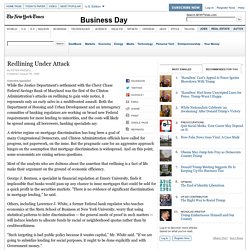
Both the Department of Housing and Urban Development and an interagency committee of banking regulators are working on broad new Federal requirements for more lending to minorities, and the costs will likely be spread among all borrowers, banking specialists say. A stricter regime on mortgage discrimination has long been a goal of many Congressional Democrats, and Clinton Administration officials have called for progress, not paperwork, on the issue. But the pragmatic case for an aggressive approach hinges on the assumption that mortgage discrimination is widespread.
Race and the New Deal Coalition. The triumph of Reaganism in the 1980s, and the attendant demise of the New Deal coalition that had formed under Roosevelt and consolidated in the postwar years, prompted a wave of reflection and debate among leftists, liberals and Democratic ideologues.
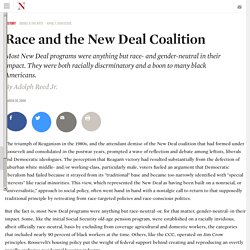
The perception that Reagan’s victory had resulted substantially from the defection of suburban white middle- and/or working-class, particularly male, voters fueled an argument that Democratic liberalism had failed because it strayed from its “traditional” base and became too narrowly identified with “special interests” like racial minorities. This view, which represented the New Deal as having been built on a nonracial, or “universalistic,” approach to social policy, often went hand in hand with a nostalgic call to return to that supposedly traditional principle by retreating from race-targeted policies and race-conscious politics.
SOC 179R/WS 585H: Gender, Race and Economic Inequality in the U.S. Syllabus - Irene Browne. Irene Browne Soc. 719R/WS 585H "Gender, Race and Economic Inequality in the U.S.
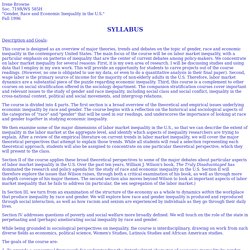
" Fall 1996 Description and Goals: This course is designed as an overview of major theories, trends and debates on the topic of gender, race and economic inequality in the contemporary United States. The main focus of the course will be on labor market inequality, with a particular emphasis on patterns of inequality that are the center of current debates among policy-makers. Bernie Sanders: Strong Words on Structural Racism and Inequality. The stakes were high for the speech by Sen.
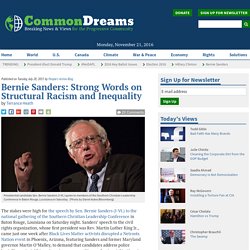
Bernie Sanders (I-Vt.) to the national gathering of the Southern Christian Leadership Conference in Baton Rouge, Louisiana on Saturday night. Sanders’ speech to the civil rights organization, whose first president was Rev. Bernie Sanders: Strong Words on Structural Racism and Inequality. Bernie Sanders' Great Response on Racism and Inequality.
The stakes were high for the speech by Sen.
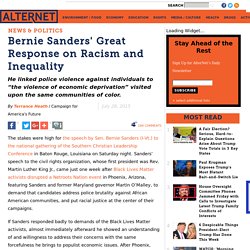
Bernie Sanders (I-Vt.) to the national gathering of the Southern Christian Leadership Conference in Baton Rouge, Louisiana on Saturday night. Sanders’ speech to the civil rights organization, whose first president was Rev. Log End of Identity Liberalism - The New York Times by Mark Lilla. When young people arrive at college they are encouraged to keep this focus on themselves by student groups, faculty members and also administrators whose full-time job is to deal with — and heighten the significance of — “diversity issues.”
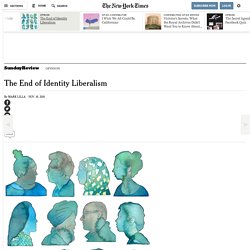
Fox News and other conservative media outlets make great sport of mocking the “campus craziness” that surrounds such issues, and more often than not they are right to. Which only plays into the hands of populist demagogues who want to delegitimize learning in the eyes of those who have never set foot on a campus. How to explain to the average voter the supposed moral urgency of giving college students the right to choose the designated gender pronouns to be used when addressing them? Race and the New Deal Coalition. How We Built the Ghettos. A brief introduction to America's long history of racist housing policy.
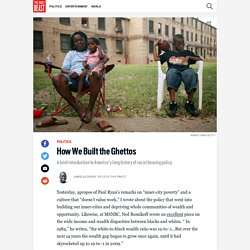
Yesterday, apropos of Paul Ryan’s remarks on “inner-city poverty” and a culture that “doesn’t value work,” I wrote about the policy that went into building our inner-cities and depriving whole communities of wealth and opportunity. Likewise, at MSNBC, Ned Resnikoff wrote an excellent piece on the wide income and wealth disparities between blacks and whites. “ In 1984,” he writes, “the white-to-black wealth ratio was 12-to–1…But over the next 14 years the wealth gap began to grow once again, until it had skyrocketed up to 19-to–1 in 2009.”
Occupaion Inequality & Racism. Education & Racism. Racialized Poverty in America has Nearly Doubled in 21st Century. Discriminatory housing, zoning, and other policy choices are driving the dramatic rise of racialized poverty and segregation across the United States, with the number of people residing in low-income "ghettos, barrios, and slums" nearly doubling in the 21st century alone, a new report finds. Architecture of Segregation, authored by the Century Foundation fellow Paul Jargowsky, concludes that midsized cities of 500,000 to 1 million people like Detroit, Milwaukee, and Cleveland are ground zero for the rapid concentration of black poverty. Poverty is becoming dramatically more concentrated, as "more than one in four of the black poor and nearly one in six of the Hispanic poor lives in a neighborhood of extreme poverty, compared to one in thirteen of the white poor," notes Jargowsky, who is also a professor of public policy at Rutgers University.
Children are the most vulnerable, he explains, as they are "more likely to reside in high-poverty neighborhoods than poor adults. " Sanders, Confrontation w/ Black Lives Matter. Racism/Inequality/Hate. Inequality. Inequality. Inequality.